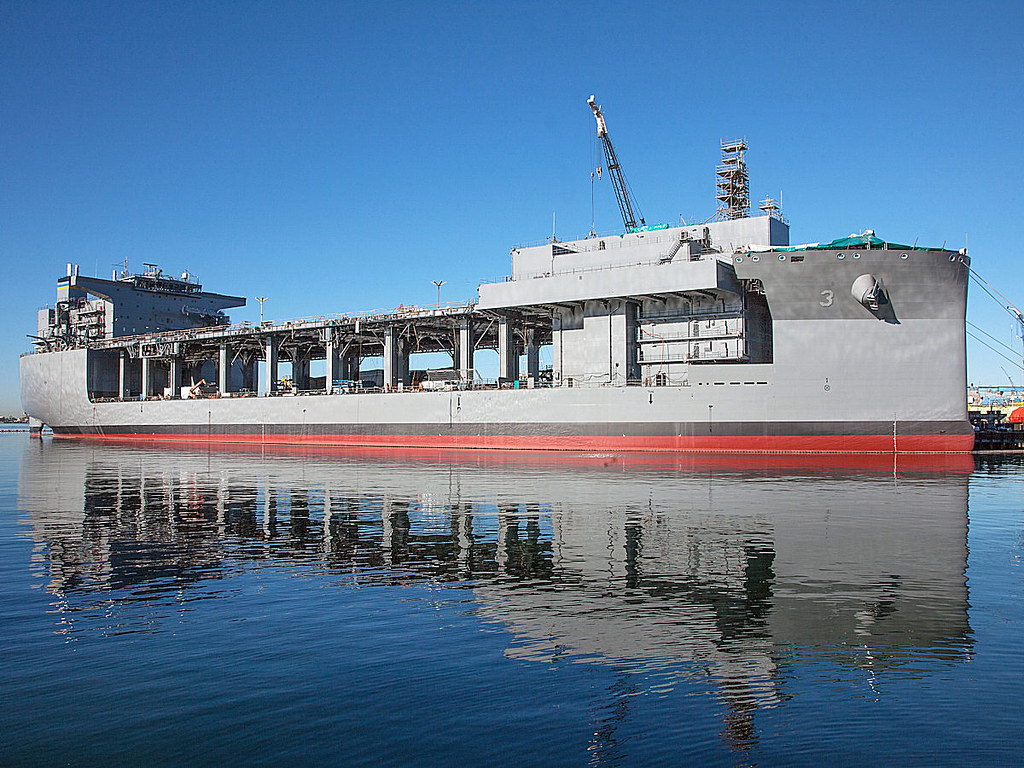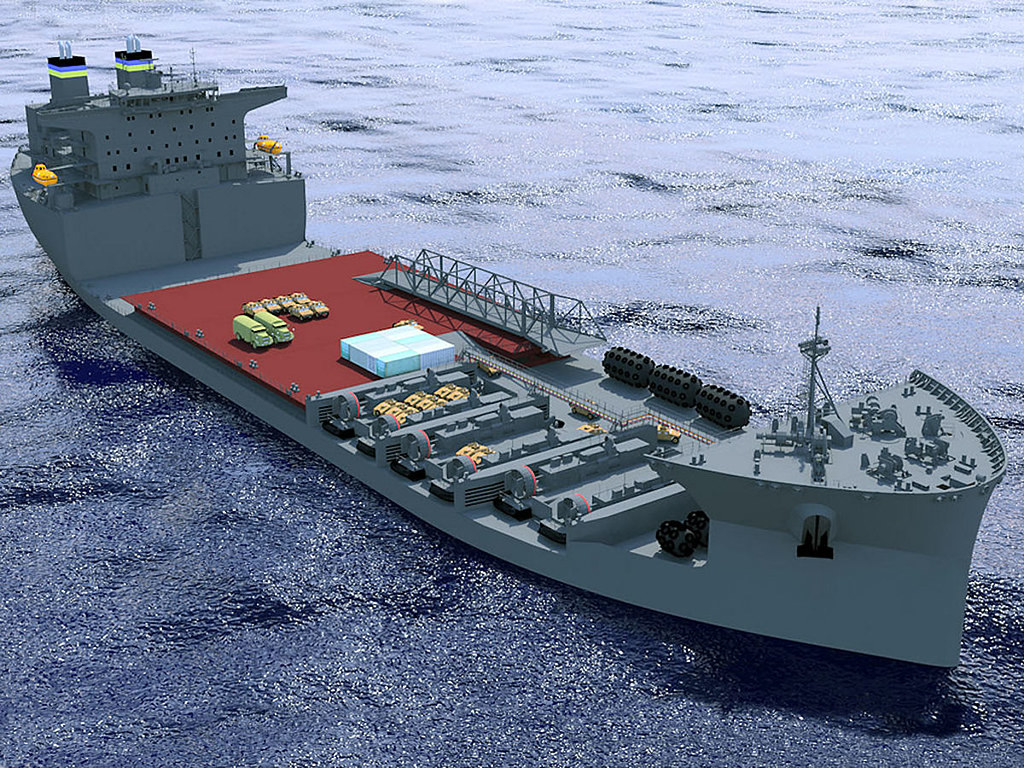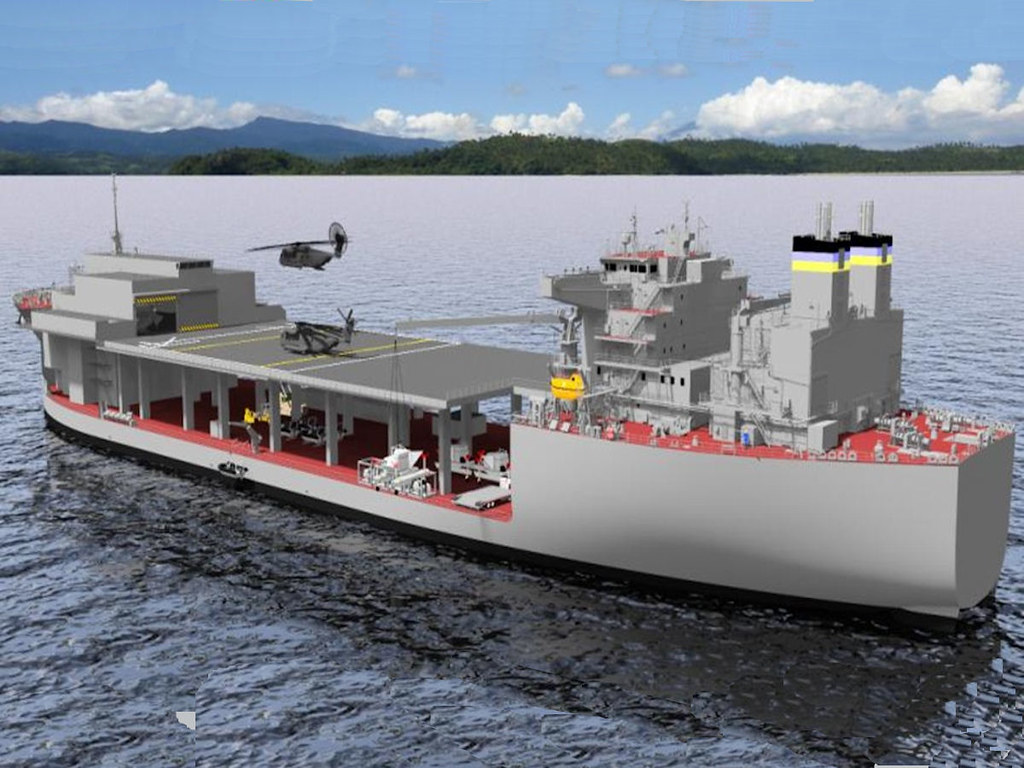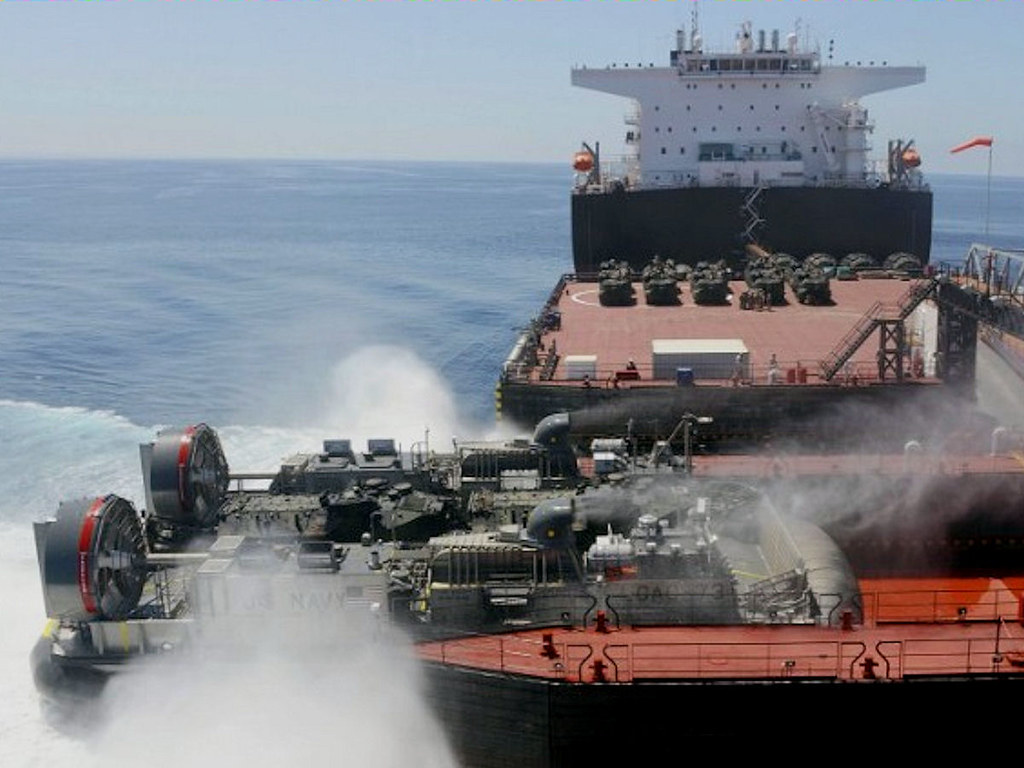THE AFSB PROGRAM
The United States Navy is moving forward with its advanced amphibious program based on the SeaPower21 and sea-basing initiatives to meet the U.S. Marine Corps' future requirements and to support joint forces' ability to launch combat power from the sea in support of the the Wasp Class LHDs, the America Class LHAs, and the San Antonio Class LPDs.
A foremost capability in this regard is the Afloat Forward Stagin Base (AFSB). This will be a large ship with multiple capabilities. it will indlucde a large flight deckc from which MV-22 Ospreys and US helicopters (from MH-53 Mine hunting helos, down to Sea Hawk helos) will be able to operate. It will also include Roll-on/Roll-Off (RORO) capabilities and transfer at sea capabilities to other vessels, from Mobile Landing Platforms, to LHDs and LHAs to LCACs. Specifically, each ship would provide a 1,000' flat helicopter launch deck with 2 aircraft elevators and 1 container elevator. Each must be capable of holding 30 VTOL aircraft and 1,000 soldiers, with a 6-story modularized office space (TOC), along with a dry cargo area and an area for ammunition magazines. The forced-entry capability might consist of 12 UH-60 Black Hawk, 6 CH-47 Chinook, 6 AH-64 Apache Longbow, and 6 OH-58D Kiowa Warriors. In support it would have Aviation maintenance and FARP capability
In addition, larger hospital spaces and command and control spaces as well as, of course, crew and troop berthing spaces will be included.
With all of these features, these vessels will figure into and operate heavily in several roles, either supporting or taking active part in Amphibious Assault operations, Mine Clearing Operations, Staging Operations for either of the foregoing, acting as a hub for coastal patrol operations or riverine operations, and humanitarian operations. The crew will be made up of both active duty Naval personnel as well as a relatively large portion of civilian personnel from the US Military Sealift Command.
INTERIM AFSB, USS PONCE, AFSB-I

Currently, an "Interim" AFSB has been produced from the USS Ponce. Ponce was formerly the USS Ponce, LPD-15, an Amphibious Assault vessel of the Landing Platform Dock variety and one of the Austin Class vessels. She was commissioned as such in 1971 and she served capably in that role. The Austin class were 16,000 ton full load vessels that had a well deck to accomoadte landing craft of various sizes including one LCAC. They also had a flight deck and could carry up to six large US military helicopters.
With the building of the San Antonio Class LPDs, the Austin class were decommissioned. The last existing Austin Class was the USS Ponce, LPD-15 and she was scheduled for decommissioning in 2012-2013.
Howecver, in 2012, the US Central Command issued an emergency request to refit the Ponce as the first AFSB and list her as an interim AFSB until pupose built AFSB vessels could be built.
As a result, the USS Ponce, AFSB-I was created. She completed her refit in June 2012. Her LPD capabilities with the well deck remain, but her communications and command and control, as well as other outfitting were updated to accomodate here AFSB mission. A high-tech Joint Operations Center was also added for communications during, and potential control of Joint Opertions at Sea. She is armed with two CIWS 20mm Phalanx systems, two MK-38 25mm auto cannons, and six .50 caliber amchine guns for close in protection. In addition, she was outfitted to deploy and recover a ScanEagle surveillance UAVwhich will keep an eye on the sea for miles around all day long.
In its new role, the Ponce is initially intended to be a close-to-the-action support hub for mine-clearing ships, coastal patrol vessels and helicopters. Ships can take on fuel and supplies without having to return to port, and a wide range of repairs can be handled by machinists onboard. That means much less downtime for minesweepers and other vessels using the Ponce as a stopping-off point instead of having to return to a base ashore.
The Ponce's accommodation can also handle hundreds of additional personnel, such as French or other nation's anti-mine divers. In theory, special operations forces could also operate from the Ponce, which is able to launch the small boats and helicopters they often use
Her intial operational duties were established to be the center piece of a large mine clearing operation prepared for use in the Persian Gulf as a contingency against the stated threats by the Iranian government to close down the Staraits of Hormuz in the event the US and ISrael or their allies attempted to stop Irans nuclear development programs.
The USS Ponce, AFSB-I is currently deployed in Persian Gulf region. Of the deployment, the US Central Command said the following:





FUTURE PURPOSE BUILT AFSB VESSELS
Current US Navy plans call for the building of the first purpose built AFSB by 2015. This will likely be the result of a prooduction program that includes taking a very well known and reliable container ship design, navalizing it, and then supplying it with the necessary pupsoe built modular compnents to fit the needs outlined in the description aboive. Such a vessel is likely to displace upwards of 30,000 tons. An excellent depiction of this porcess and resulting vessel is provided in the following video produced by one of the leading contenders for the design and production contract, MAERSK.
The MAERSK design is not necessarily the preferred or chosen design at this point. In addition to that design, others design considerations, both commercial conversions and existing military vessels, are depicted by the following:




Of these, the first two seem to meet the requirement put forth of a 1000' landing deck most closely.
It is expected that the development and building of these vessels will occur rapidly once a decision is made. A Market Study Porposal was sent out by the Military Sea Lift Command and responses were due early in 2012. no decision has yet been announced. In order to meet a luanch date of 2015, however, it is expected that the vessel will have to begin building no later than the middle to the end of the 2013 year time frame, which means within the year, in order to minimally meet the initial schedule for the first vessel, that vessel will have to be awarded and start building.
The United States Navy is moving forward with its advanced amphibious program based on the SeaPower21 and sea-basing initiatives to meet the U.S. Marine Corps' future requirements and to support joint forces' ability to launch combat power from the sea in support of the the Wasp Class LHDs, the America Class LHAs, and the San Antonio Class LPDs.
A foremost capability in this regard is the Afloat Forward Stagin Base (AFSB). This will be a large ship with multiple capabilities. it will indlucde a large flight deckc from which MV-22 Ospreys and US helicopters (from MH-53 Mine hunting helos, down to Sea Hawk helos) will be able to operate. It will also include Roll-on/Roll-Off (RORO) capabilities and transfer at sea capabilities to other vessels, from Mobile Landing Platforms, to LHDs and LHAs to LCACs. Specifically, each ship would provide a 1,000' flat helicopter launch deck with 2 aircraft elevators and 1 container elevator. Each must be capable of holding 30 VTOL aircraft and 1,000 soldiers, with a 6-story modularized office space (TOC), along with a dry cargo area and an area for ammunition magazines. The forced-entry capability might consist of 12 UH-60 Black Hawk, 6 CH-47 Chinook, 6 AH-64 Apache Longbow, and 6 OH-58D Kiowa Warriors. In support it would have Aviation maintenance and FARP capability
In addition, larger hospital spaces and command and control spaces as well as, of course, crew and troop berthing spaces will be included.
With all of these features, these vessels will figure into and operate heavily in several roles, either supporting or taking active part in Amphibious Assault operations, Mine Clearing Operations, Staging Operations for either of the foregoing, acting as a hub for coastal patrol operations or riverine operations, and humanitarian operations. The crew will be made up of both active duty Naval personnel as well as a relatively large portion of civilian personnel from the US Military Sealift Command.
INTERIM AFSB, USS PONCE, AFSB-I

Currently, an "Interim" AFSB has been produced from the USS Ponce. Ponce was formerly the USS Ponce, LPD-15, an Amphibious Assault vessel of the Landing Platform Dock variety and one of the Austin Class vessels. She was commissioned as such in 1971 and she served capably in that role. The Austin class were 16,000 ton full load vessels that had a well deck to accomoadte landing craft of various sizes including one LCAC. They also had a flight deck and could carry up to six large US military helicopters.
With the building of the San Antonio Class LPDs, the Austin class were decommissioned. The last existing Austin Class was the USS Ponce, LPD-15 and she was scheduled for decommissioning in 2012-2013.
Howecver, in 2012, the US Central Command issued an emergency request to refit the Ponce as the first AFSB and list her as an interim AFSB until pupose built AFSB vessels could be built.
As a result, the USS Ponce, AFSB-I was created. She completed her refit in June 2012. Her LPD capabilities with the well deck remain, but her communications and command and control, as well as other outfitting were updated to accomodate here AFSB mission. A high-tech Joint Operations Center was also added for communications during, and potential control of Joint Opertions at Sea. She is armed with two CIWS 20mm Phalanx systems, two MK-38 25mm auto cannons, and six .50 caliber amchine guns for close in protection. In addition, she was outfitted to deploy and recover a ScanEagle surveillance UAVwhich will keep an eye on the sea for miles around all day long.
In its new role, the Ponce is initially intended to be a close-to-the-action support hub for mine-clearing ships, coastal patrol vessels and helicopters. Ships can take on fuel and supplies without having to return to port, and a wide range of repairs can be handled by machinists onboard. That means much less downtime for minesweepers and other vessels using the Ponce as a stopping-off point instead of having to return to a base ashore.
The Ponce's accommodation can also handle hundreds of additional personnel, such as French or other nation's anti-mine divers. In theory, special operations forces could also operate from the Ponce, which is able to launch the small boats and helicopters they often use
Her intial operational duties were established to be the center piece of a large mine clearing operation prepared for use in the Persian Gulf as a contingency against the stated threats by the Iranian government to close down the Staraits of Hormuz in the event the US and ISrael or their allies attempted to stop Irans nuclear development programs.
The USS Ponce, AFSB-I is currently deployed in Persian Gulf region. Of the deployment, the US Central Command said the following:
US Central Command said:MINA SALMAN PIER, Bahrain - The U.S. Navy’s first Afloat Forward Staging Base- Interim USS Ponce (AFSB-I) arrived in Bahrain for duty in the U.S. 5th Fleet area of responsibility (AOR), July 6.
Prior to arriving in theater, Ponce, formerly designated as an amphibious transport dock (LPD), was converted and reclassified as an AFSB(I) in April to fulfill a long-standing U.S. Central Command (CENTCOM) request for an AFSB to be located in its AOR.
“Ponce’s role as an AFSB provides us with an enhanced capability to conduct maritime security operations, and gives us greater flexibility to support a wide range of contingencies with our regional partners,” said Vice Adm. John Miller, commander, U.S. Naval Forces Central Command (NAVCENT).
Ponce’s primary mission is to support mine countermeasures (MCM) operations and other missions, such as the ability to provide repair service to other deployed units, including electrical, diesel engine, piping, and machinery repairs. Additionally, Ponce also has the capability to embark and launch small riverine craft.
Commanded by a U.S. Navy Captain, Ponce will remain a U.S. Navy ship. The newly classed AFSB will be manned by a “hybrid” crew consisting of approximately 150 Military Sealift Command (MSC) civilian mariners and 55 U.S. Navy Sailors. Sailors will be primarily responsible for the ship operations. MSC personnel will man the engineering, deck and damage control departments.
“The versatility of Ponce, combined with the teamwork of its ‘hybrid’ crew, brings a unique capability to the region." said Capt. Jon Rodgers, commanding officer of Ponce. "As the first dedicated Afloat Forward Staging Base, we look forward to working closely with our coalition and regional partners to promote security and stability."





FUTURE PURPOSE BUILT AFSB VESSELS
Current US Navy plans call for the building of the first purpose built AFSB by 2015. This will likely be the result of a prooduction program that includes taking a very well known and reliable container ship design, navalizing it, and then supplying it with the necessary pupsoe built modular compnents to fit the needs outlined in the description aboive. Such a vessel is likely to displace upwards of 30,000 tons. An excellent depiction of this porcess and resulting vessel is provided in the following video produced by one of the leading contenders for the design and production contract, MAERSK.
[video=youtube;Xn5v7tEBYn4]http://www.youtube.com/watch?v=Xn5v7tEBYn4[/video]
The MAERSK design is not necessarily the preferred or chosen design at this point. In addition to that design, others design considerations, both commercial conversions and existing military vessels, are depicted by the following:




Of these, the first two seem to meet the requirement put forth of a 1000' landing deck most closely.
It is expected that the development and building of these vessels will occur rapidly once a decision is made. A Market Study Porposal was sent out by the Military Sea Lift Command and responses were due early in 2012. no decision has yet been announced. In order to meet a luanch date of 2015, however, it is expected that the vessel will have to begin building no later than the middle to the end of the 2013 year time frame, which means within the year, in order to minimally meet the initial schedule for the first vessel, that vessel will have to be awarded and start building.













